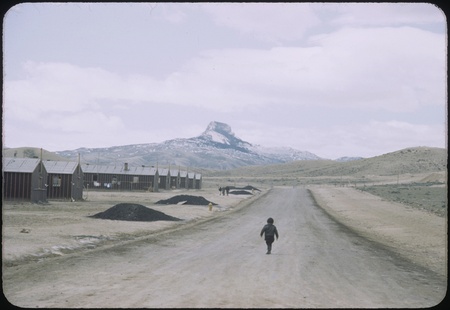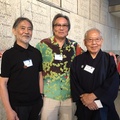During World War II, amateur photographer Bill Manbo had a camera with him while unjustly incarcerated in a Japanese American concentration camp.
Nearly 70 years later, scholar Eric Muller learned about Manbo’s pictures from that period, and was stunned by what he saw.
“I felt like a cartoon character doing one of those silly dramatic triple-takes when they see something astonishing,” Muller recalls.
The pictures provided a glimpse into life behind barbed wire at Heart Mountain, Wyoming. But there was another aspect that made them extremely rare.
They were in color. Bold, beautiful color. So evocative were the images that Muller knew that they were something quite special.
“I immediately sensed that they were historical artifacts of great importance both because of the rarity of the color technology at that time and because of the range of Bill Manbo’s subjects for his photos, many of which differ from typical portrayals of the camps,” Muller says.
He had learned of the existence of Manbo’s collection while preparing the core exhibit at the Heart Mountain Interpretive Center.
“I just couldn’t believe how much more immediate and accessible and vivid and ‘present’ the color images appeared to my eye,” says Muller.
Muller saw an opportunity to bring the story of the Japanese American camps to view in a striking way. That story, notes Muller, who is also a Professor of Law at the University of North Carolina, continues to be worthy of study in the present day.
“(The camps) came from a universal human instinct to misidentify what seems ‘foreign’ as ‘dangerous’ in times of stress,” Muller says. “Some version of what happened to Japanese resident aliens and Japanese Americans in 1942 could happen to any group in any country at any time if the circumstances are in place. And courts will not be much better positioned than the rest of society to identify and remedy the wrong.”
Muller went on to produce a well-received book about the Manbo collection (Colors of Confinement: Rare Kodachrome Photographs of Japanese American Incarceration in World War II, University of North Carolina Press, 2012), and then a traveling display based on the book.
The display will be on view at the Japanese American National Museum in Los Angeles from May 3 through August 14, 2014. Believing strongly in the educational value of the subject matter, Muller is loaning the photographs to the museum for free, and has pledged to donate royalties from the sale of the book to the Heart Mountain Wyoming Foundation.
“I think the most interesting reactions (to the photos) come from some members of the Nisei generation,” says Muller. “This is a generation that endured this incarceration and the stigma and suffering that followed it, and that had to work very, very hard to establish the fundamental injustice of the episode in the eyes of white America. I often sense in Nisei observers a concern that the photographs are a little bit too beautiful—that the people pictured in them are a little bit too happy-looking. Some Nisei viewers have refused to accept that Japanese Americans would have been seen wearing kimono and other Japanese attire out in the open in camp.”
“Many viewers, JA and non-JA alike, mistakenly believe that cameras were contraband at all of the WRA camps and that taking photos like this would have been illegal or would have had to be done surreptitiously,” he adds. “This is a commonly held, but erroneous, idea.”
For Muller, the book and the display are a continuation of a career-long interest in Japanese American civil rights.
“I first dipped into the topic in the mid-1990s when I was on the faculty at the University of Wyoming College of Law,” says Muller. “I was teaching Constitutional Law to first-year students who clearly had no idea what had happened to Japanese Americans during the war and no idea that their own state had played a role in the history. I began studying the history of Heart Mountain so that I could have a ‘local interest’ angle to bring into the classroom.”
In time, as Muller delved deeper into the history of Japanese American removal and incarceration, he began to realize that the story had parallels to his own heritage.
“I am the son and son-in-law of German and Austrian Jewish refugees who fled the Nazis,” Muller says. “My grandfather was incarcerated at Buchenwald in 1938 and my great-uncle was ‘evacuated’ and murdered by the Nazis in 1942. While I don’t pretend that the two stories are identical, they do share certain important common elements. So in some ways my work on Japanese American history has been a way of approaching my own family history.”
Muller says his dream is to someday write a history of the War Relocation Authority, the U.S. government agency created to oversee the incarceration of Japanese Americans as well as those of other ethnic groups—activities later acknowledged as severe injustices.
“It would be a huge project that would take years to pull off—including lots of time in the National Archives,” he says. “But I feel that my prior work (and my understanding of legal history) position me well to undertake this project.”
In the meantime, as a professor, Muller is able share information about the incarceration with students whenever he can, and with others in his community.
“This spring I will be doing some public lectures in connection with our local repertory theater’s production of Jeanne Sakata’s play Hold These Truths, about Gordon Hirabayashi,” says Muller. “I’m looking forward to talking to audiences here in the Southeast, where there are few Japanese Americans and the principal narrative about race is the black-white narrative.”
Muller is encouraged that the Japanese American stories from World War II continue to resonate with people, seven decades later.
Whenever he shares the subject with his students, he is pleased to observe that they are “invariably interested and appreciative.”
* * * * *
SPECIAL ENGAGEMENT
Colors of Confinement: Rare Kodachrome Photographs of Japanese American Incarceration in World War II
Japanese American National Museum
May 3 – August 31, 2014
Japanese American National Museum
Los Angeles, California
© 2014 Darryl Mori








